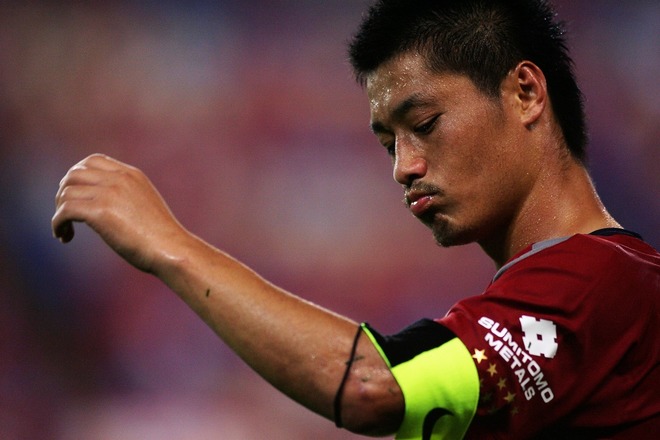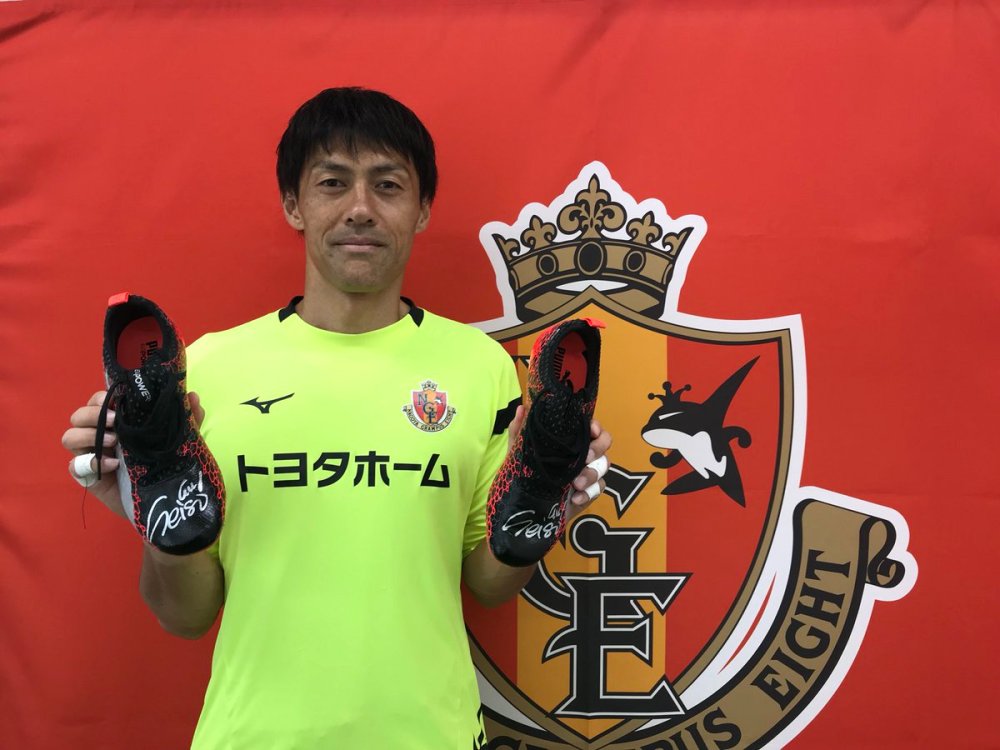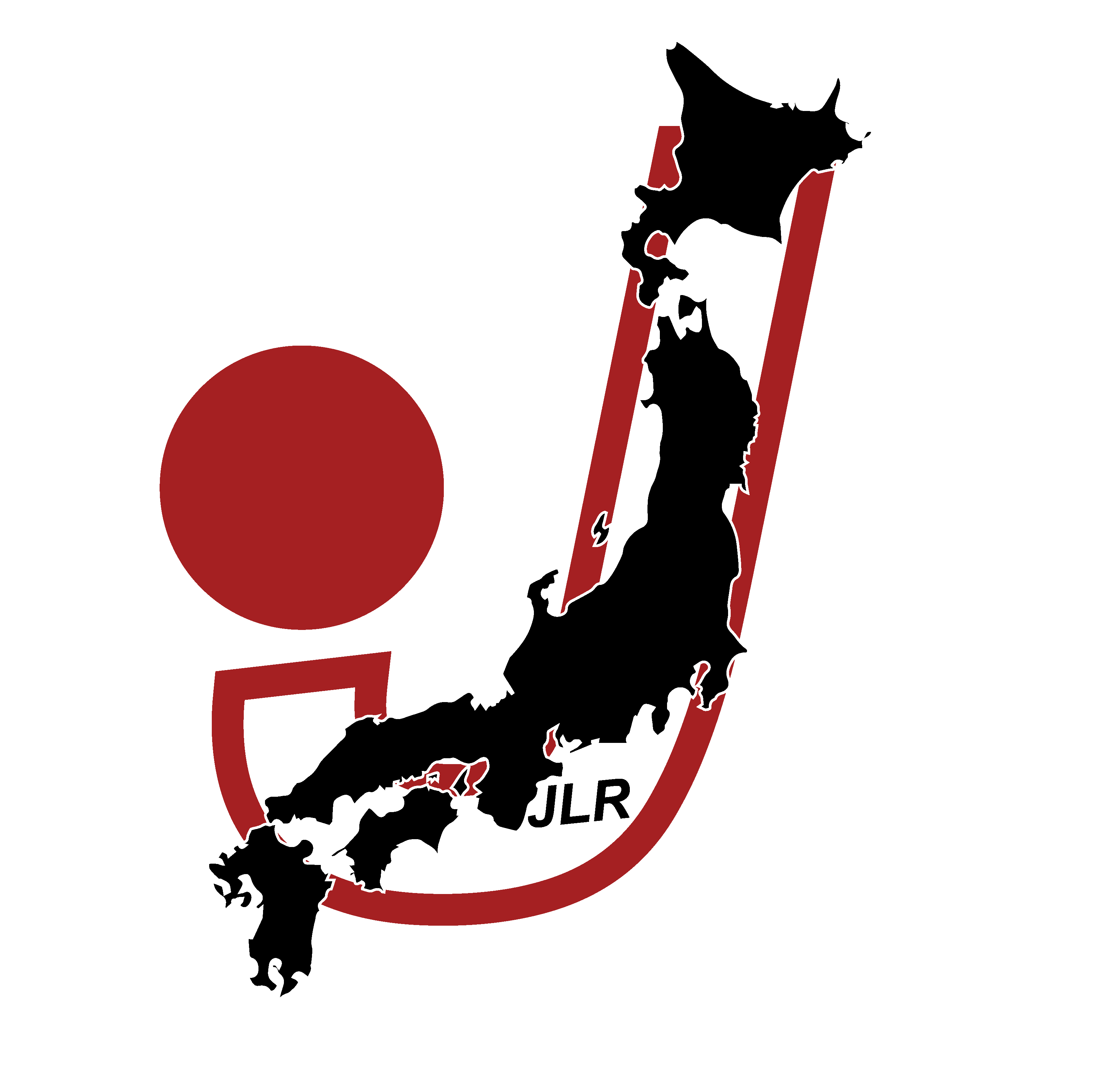Seven football knights might look for a new challenge. These homecomings may be impossible or crazy, but they would be fascinating.
When your career is going to the end, it’s normal to back down your expectations, especially if you’ve already obtained a lot from your best years. It happened, it happens and it will happen in football. You will settle with minor solutions if you’re happy enough with everything you’ve got.
We can see every weekend many J. League heroes (and former JNT members) trying to prolong their careers. But what if they should switch team, maybe even league to go on? Wouldn’t it be nice to see them in a comfortable environment, at home? We imagined six returns to their hometown, plus a consideration on a former young prodigy.
1. Shinji Ono to Azul Claro Numazu
Azul Claro Numazu just started their adventure in pro football, but they’re doing pretty well, if you think about it: they almost topped the league before having a bad string of results in the last season. Yet, if they somehow managed to obtain a J2 license, they could really point towards promotion. But wouldn’t they need a prestigious help?
Shinji Ono is still “Tensai” for everyone in Japan. You can see from the public’s eyes when he plays in Sapporo, since he has signed with Consadole in 2014, after winning an historical AFC Champions League with Australian club Western Sydney Wanderers. And he left a lot of memories in Sydney.
Ono will probably go down in the history of Japanese football to be the most under-rated player ever, since he won a lot in his career – even in Europe – but he has been less considered than team-mates like Hidetoshi Nakata or Shunsuke Nakamura. Still, wouldn’t it be nice to close it all at home, in Numazu? He was born there in 1979, when all started.
This year he played just six times with Consadole, for a total 256′ in all competitions… maybe there will be more space in Azul Claro. And he could find an old friend like Masashi Nakayama.
2. Keiji Tamada to Briobecca Urayasu
It’s strange for Tamada. We are talking about a player who has done a lot for Japanese football, yet with little recognition overseas. Apart from his goal against Brazil in 2006 FIFA World Cup, maybe no one knows him outside Asia. Yet, Tamada is still playing in J1 and he even scored this year with Nagoya.
Born in Urayasu, Chiba, his journey has been satisfying. Kashiwa Reysol launched him and then he became a part of Nagoya Grampus’ history: Tamada is playing the 11th season in Nagoya, interspersed with a two years-spell at Cerezo Osaka. He never had a striking goal-form (he scored a double digits of goal only in five seasons), but he could be a factor to bring Briobecca Urayasu back in Japan Football League.
Especially because the club was promoted to JFL from Kanto Soccer League, but they’ve not exactly performed: in 2017 season, Briobecca got relegated after coming short of just one point to MIO Biwako Shiga and Verspah Oita, both saved.
3. Mitsuo Ogasawara to Grulla Morioka
It’s even hard to imagine Mitsuo Ogasawara away from his only club, Kashima Antlers. He has been there from 1998 and today he’s still the captain, proudly guiding his team-mates (he never went under 30 caps in all competitions from 2006 to 2017: last season he played “just” 26 games). Aside from a brief spell in Italy with Messina, he has been the light in the dark for Kashima.
Plus, we are talking about a man who gained 55 caps and seven goal with Japan national team. Ogasawara – just like Ono, maybe even more – is a landmark of Japanese football history. But it would be nice see him moving just a few miles North, to come back home.
Born in Morioka, Iwate Prefecture, the city hosts one of J3 League teams, Grulla.
The club hasn’t done exactly well: Grulla had certainly some interesting players (Tanimura, Fujinuma), but they haven’t delivered after a promising 5th place in the debut season of J3 League in 2014 (11th in 2015, 13th in 2016 and 15th in 2017). Grulla are languishing at the bottom of the championship: despite their start in 2018 has been slightly better (12th for now), maybe they need an expert guide, just as Ogasawara could be.

4. Daisuke Nasu to Kagoshima United FC
The heart would say that seeing Yasuhito Endo back in Kagoshima would be amazing and probably a massive push for both the club and the city. Realistically, though, Endo should finish his career with Gamba; more likely, Daisuke Nasu could be a target for a homecoming return in Kagoshima. The centre-back is aging and he even left Urawa Red Diamonds after Petrovic was sacked: no more space for him without a three-center backs line and so Nasu joined Vissel Kobe.
At this, you have to add current situation for Kagoshima United Football Club: after seeing the merge between FC Kagoshima and Volca Kagoshima, the new-born club did a pretty good job, getting promoted to J3 League and then sealing two solid finishes (5th place in 2016 and 4th in 2017). Despite losing the man who brought them there – Tetsuya Asano, now in Nagano –, Kagoshima had still lived a top-table season under the management of Yasutoshi Miura.
After getting a J2 license, Nasu could be a nice add for the team, maybe hoping to find that little step to get another promotion.
5. Seigo Narazaki to Nara Club
We noticed, we are not blind. Seigo Narazaki is a true legend, not only for Nagoya Grampus, but also for the whole football movement in Japan. Just like his long-timed team-mate in Japan national team, Yoshikatsu Kawaguchi, he featured in four consecutive World Cups, despite being the starter only in the home edition of 2002.
Kawaguchi was preferred in ’98 and 2006, while Kawashima benched both veterans in 2010. Yet, Kawaguchi has still faced the best of his career: he played in Europe, he even featured in both AFC Asian Cup wins by Japan and now he’s playing in J3 League with SC Sagamihara. If we can probably try a comparison, Kawaguchi was Japan’s Buffon, while Narazaki was like Francesco Toldo: talented, different and mostly left aside.
His career followed that trajectory for a while. He was a member of Yokohama Flügels, the other historical side of this city: Flügels were disbanded in ’99, just after lifting the Emperor’s Cup, and Narazaki was the starter GK of that club. After that, Narazaki took the road to Nagoya, where he became a legend. He took him a lot to win the J. League, but in the end he did it in 2010 as MVP of that season.
You can see the reason why in a simple number: like “The Japan Times” reported, Nagoya allowed the second-highest number of shots in the league with 483 — only relegated Shonan Bellmare allowed more with 575 —, but they still won the championship after letting in the third-fewest goals (37) from the 34 games. And as today, Narazaki is also the holder of the record for the highest number of games played in J1 (631).

Yet, you could see how Narazaki is fading in the last years. He isn’t effective as he used to be and you can also explain Nagoya’s relegation in 2016 with that particular. Narazaki played his first game in J2 ever in March 2017, but manager Yahiro Kazama benched him mid-season in favour of Yohei Takeda. Then Nagoya signed Mitchell Langerak and Narazaki became the third-choice at the club. What if he starts over from somewhere else?
His hometown could be a solution. Narazaki was born in Kashiba, a small city in Nara Prefecture, where Nara Club is trying to reach that long-waited spot in pro football. The club has already obtained their J. League license, but results are not coming their way: after coming twice 7th and once 11th in their first three JFL seasons, promotion may come at the end of 2018. With Narazaki featuring in their first J3 League-season ever, something might change.
6. Kazuyoshi Miura to YSCC Yokohama
I don’t have to explain the greatness of Kazuyoshi Miura: the echo of his legend reached every spot of the world, so at 51 years old you could say he achieved everything he could desire. King Kazu even scored at the beginning of 2017 season against Thespakusatsu Gunma, de facto entering the scorers’ table few days after his birthday. Yet, there’s a final hope.
Yokohama FC have been his home for more than a decade, but Miura has not played so much in 2018: just nine appearances, seven short cameo in J2 League (46’ in total) and two good games in Emperor’s Cup. He also featured on the field at the same time with Koki Saito, 16 years old! Yokohama FC are having a good run at J1 promotion, since they’re currently 4th after resoundingly missing the play-offs last season (sacking Hitoshi Nakata was a really bad idea).
Given their 12 years-bond, YFC and King Kazu shared a mutual agreement: he needed them to keep playing at a certain level, they needed him for his fame. On the field, thought, the club proved to be more than Miura. With his contract running out at the end of the year and not much time spent on the field, there’s a chance Miura could leave. And he’s could have some market if he wants to continue, so… what could be next for him?
Of course, he could just retire. He is 51 years old and he proved everyone wrong. Or… he could stay in the city, just in a different league. Yes, because YSCC Yokohama feature in J3 League, just one division above Yokohama FC, without any dream of promotion to J2. Yet, their attendances are not great (the average in 2017 season is… 951) and the arrival of a king might help the club.
Moreover, imagine this: Kazuyoshi Miura might enter the club of the players who scored in all three pro-divisions of Japanese football. In addition, it might be even funnier to witness that if he can score against U-23 sides, with kids having 30-35 years younger than him.
Bonus Track – Masatoshi Kushibiki to ReinMeer Aomori FC
This is a strange suggestion, but there is a reason. In 2017 season, two players were on loan to Fagiano Okayama from Shimizu S-Pulse. Both represented Japan’s future in football and now it seems even strange to remind that. But if IMHO Hideki Ishige – 2011 AFC Young Player of the Year – has still a chance to redeem himself and at least he regularly played with Fagiano, it’s a different story for Masatoshi Kushibiki.

It’s incredible to see how his career went downhill, despite the fact he started in one of three matches played by Japan U-23 in Rio 2016. Manager Makoto Teguramori incredibly picked him over Kosuke Nakamura for the first game, then Nigeria won 5-4 against Japan and order was restored in the GK position.
Nevertheless, Kushibiki has been a young prodigy for several years. Shimizu S-Pulse took him with the Shizuoka side at the age of 18 and just two years later Kushibiki started to appear regularly under Afshin Ghotbi. Even when Shimizu was relegated to J2 in 2015, the GK was picked by Kashima Antlers to join Ibaraki-based club on loan. He never played in the league, but it was still a sign of value.
You would have expected to see him rise in Okayama, where Fagiano lost one of their stars – Hirotsugu Nakabayashi, gone back to Sanfrecce Hiroshima – and needed a new face for the role. Kushibiki lasted only six games before being replaced by former Renofa Kawaguchi goalkeeper Jun Ichimori. Then his manager, Tetsu Nagasawa, has never fielded him again in J2, while made him play in two Emperor’s Cup matches.
Kushibiki has then come back to Shimizu, which bought Yuji Rokutan from Vegalta Sendai to be the starter. So… no space for him in Shizuoka. The club who cherished him so much sold him to Montedio Yamagata for good, where Kushibiki is playing – 13 games, 14 goals allowed – after almost losing another chance. Then manager Kiyama dropped his favourite, Tsuyoshi Kodama, and Kushibiki regained some fitness to defend Montedio’s goal.
But what about starting back from his roots? Kushibiki was born in Aomori, where ReinMeer are doing a great job and they might actually point to J3 if they get the pro-license. In 2017, the Aomori-based club closed the season as runners-up of Japan Football League. Who knows?
